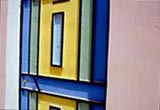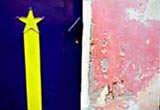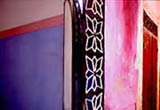|
|
 |
 |
 |
WHERE AND WHAT IS AMIRA? The photo-imagescape by Karl Grimes is a representation of its eco-media. In its entirety, it becomes a visual commentary about our deepest sources for any impression of place, mysterious integrations of evocative popular icons and prismatic individual references. Amira's entrance arch, shadowed by palm fronds, invites travellers to explore origins of interpretation, of what seems familiar or unfamiliar. Inside Amira's walls, a pseudo-paradise awaits, a vibrant display of tensions created by cross-cultural fusion. However, those who enter Amira would not be burdened by ominous warnings of abandoning hope; Amira's creative connections, however transitory or partial, revive us, speaking to our capacities for resilience and adventure. What sort of beauty spot is Amira? Is it a construction reminiscent of outrageous promises such as those found in a seedy travel brochure? Perhaps so. We certainly are transported into a world of ambiguous meanings, jubilant colours, and uneasy marvels. Amira vibrates with the stuff of which startling daydreams are made. Sooner or later, we catch ourselves wondering: Is anything in Amira real? Curious about this place, we search for evidence of its everyday society; ironically, we must rely on our guide's notoriously deceptive medium; the camera. Grimes' photographs of pictures that hang on unspecified Amirian walls are evidence of its unique reality, a trail of obscure and fantastic horizons. Nonetheless, our world resembles Amira. We find that Elvis rules there too, sharing power with an aloof silver-gloved starlet. Her gaze, slightly eluding ours, is sheltered by gossamer blue palm fronds. Time and status isolate her from our taboos. Even
as we acknowledge aristocracy in Amira, we wonder about its ordinary people.
Only one photograph reveals a body, and it is impossible to know whether
he is one of us or one of them: a hotel guest or a casual citizen. Further
on, we remain mystified by local store displays of bottled liquids, indecipherably
labeled in Arabic script. Later, we pass an ebony horse's head and intricate
tapestries, displayed beside faux-modish western jackets on offer for
us. Perhaps our question really must be: Who do Amirans think we are?
The work is not presented as separate photographs. alligned one-by-one for singular contemplation. Instead, we are met by imposing, fragmented imagery: vivid triptychs. As eager tourists, recapturing a giddy desire to escape, we can succumb to every detail, every play of reflection and light, wandering beside Grimes into odd corners and hallways of Amira, where we are reminded of how we thought we knew other places. In the end, Amira is not confined by territorial boundaries. Its images extend our awareness of shared memories. A line of trees disappears into an unmarked horizon. The Empire State Building somehow can be secure against a geometrically constructed background, still surpassing all pyramids of skylights nearby. A painted door, mirrored in sky-blue steps, waits to be opened. Is Amira more or less than we hoped? Would another excursion there confirm or call into question our momentary intuitions about its meaning? Doubtless, wherever we journey, burdened with cameras and cases, we venture out, making incredible guesses about what seems artificial or authentic or baffling. In this exhibition of brilliantly oblique photographs, Grimes reminds us that our uncertainty is a gift. It has power to reawaken that fragile beginning of sensitivity called curiosity. Indeed, by the end of these disconcerting and intriguing travels, our impressions and interpretations, whether of Amira or of ourselves, remain fleeting approximations, resonating with possibilities.
Dr Barbra S. Morris. University of Michigan.
|
|||||||||||||||||||||||||||||||||
|
www.karlgrimes.net
|